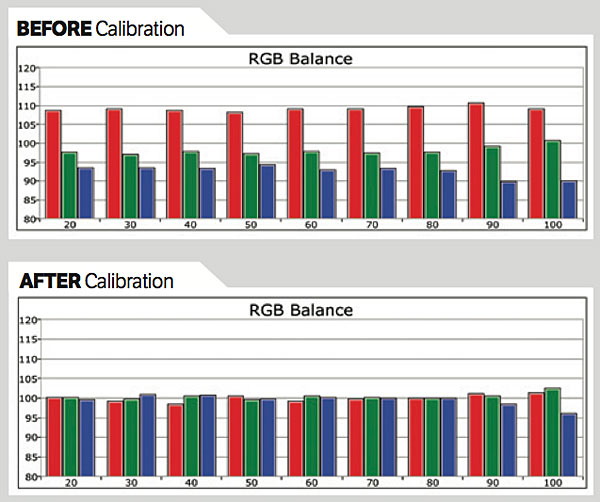Mitsubishi HC8000D 3D DLP Projector Test Bench
Full-On/Full-Off Contrast Ratio: 3,596:1
All the measurements here, unless noted otherwise, were taken in 2D on a 96-inch-wide, Stewart StudioTek 130 G3 screen (gain 1.3), with the projector in an AV Memory mode and the Gamma in User mode (Reference 2.4, all custom settings at 0). The Iris was set to Auto3 and High Contrast, the Lamp Power to Standard (high), the Contrast at 0, the Brightness at 12, and BrilliantColor on. All measurements and viewing were done with between 150 and 270 hours on the projection lamp.
The above contrast ratio was measured off the screen with a Minolta LS-100 light meter, at a measured peak white level of 17.98 foot-lamberts and a black level of 0.005 ft-L. With the Iris on but the Auto iris off, in the High Contrast setting, the peak white level increased to 18.52 ft-L and the black level to 0.01 ft-L, for a full-on/full-off contrast ratio to 1,852:1. In the High Brightness/Auto3 iris settings, the peak white level measured 20.65 ft-L and the black level 0.006 ft-L (all other settings unchanged), for a full-on/full-off contrast ratio of 3,442:1.

The RGB Color Balance charts show graphically how closely the Mitsubishi adheres to the D65 Rec. 709 HD standard. The tighter the match of the three primary colors, the nearer the result is to D65. Delta E is a figure of merit that rates this accuracy; the lower the Delta E, the better the result. A Delta E of under 3.0 (some experts say 4.0) indicates deviations that should be imperceptible to the eye.
Pre-calibration, the Mitsubishi looked better than it measured, with an average gray scale Delta E of 6.47 (1.73 at 20 percent brightness, increasing to 11.94 at 100 percent) and an average color gamut Delta E of 5.59. Post calibration, the gray scale Delta E averaged 1.05 (maximum 0.61 at 80 percent brightness or lower, increasing to 5.3 at 100 percent), and the color gamut Delta E averaged 2.58. The gamma (Reference setting 2.4) averaged 2.11—it averaged about 2.2 up to 50 percent brightness but decreased to 1.81 at 90 percent with the Iris set to Auto3.
For 3D prior to calibration, in the 3D Gamma mode with the Iris on Auto3, High Brightness, but the other controls otherwise unchanged from their 2D settings, the gray scale Delta E averaged 18.15 as measured through the active 3D glasses. This looked more acceptable than you might suspect, particularly with the animated fare that dominates 3D programming. After calibration, this average dropped to a more acceptable 2.35 for the gray scale (under 2.02 up to 80 percent increasing to 9.26 at 100 percent). Unfortunately, the calibration dropped the peak 3D brightness level from an already dim, pre- calibration 3.15 ft-L to a post-cal 2.48 ft-L. A low gamma is used in many displays to help compensate for their limited 3D peak brightness. That was the case here, with an average 3D gamma of 1.76 (high, 1.82 at 20 percent, low 1.52 at 90 percent).—TJN





























































